Taxation Law Assignment: Capital Gains, Fringe Benefits, and Income
VerifiedAdded on 2020/04/01
|10
|1955
|170
Homework Assignment
AI Summary
This taxation law assignment delves into several key areas of tax law, including the determination of net capital gains and losses, the computation of taxable fringe benefits, the allocation of losses from rental properties, the principles of tax avoidance as illustrated by the Westminster case, and the assessment of income derived from timber sales. The assignment applies relevant legislation, such as the Income Tax Assessment Act 1997 and related taxation rulings, to various scenarios involving the sale of assets, fringe benefits provided to employees, joint ownership of rental properties, and income derived from timber. It analyzes the application of these laws, provides computations for taxable amounts, and discusses the implications of legal precedents such as the Duke of Westminster case and the Ramsay principle. The assignment provides a detailed analysis of tax law principles and their practical application.
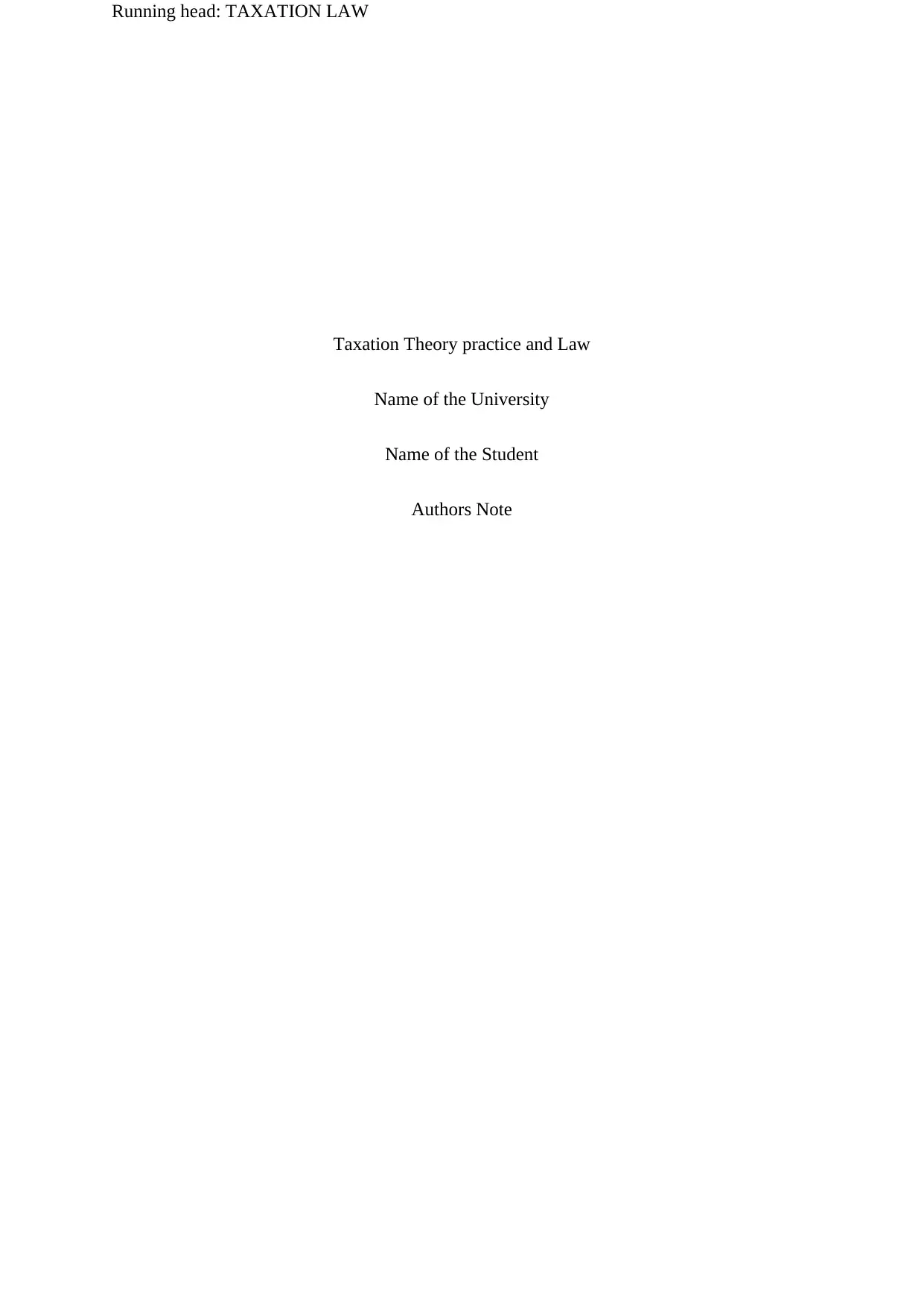
Running head: TAXATION LAW
Taxation Theory practice and Law
Name of the University
Name of the Student
Authors Note
Taxation Theory practice and Law
Name of the University
Name of the Student
Authors Note
Paraphrase This Document
Need a fresh take? Get an instant paraphrase of this document with our AI Paraphraser
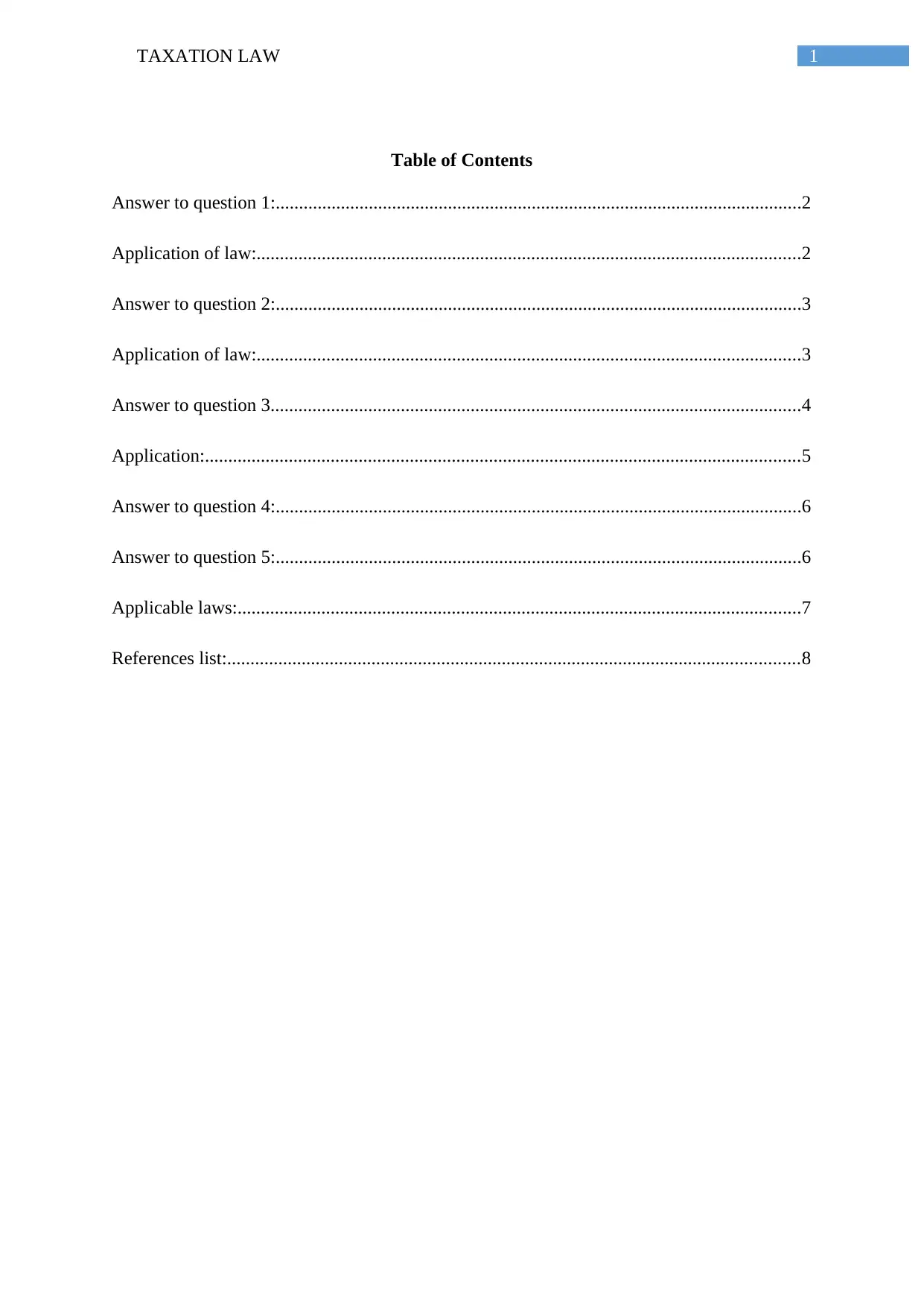
1TAXATION LAW
Table of Contents
Answer to question 1:.................................................................................................................2
Application of law:.....................................................................................................................2
Answer to question 2:.................................................................................................................3
Application of law:.....................................................................................................................3
Answer to question 3..................................................................................................................4
Application:................................................................................................................................5
Answer to question 4:.................................................................................................................6
Answer to question 5:.................................................................................................................6
Applicable laws:.........................................................................................................................7
References list:...........................................................................................................................8
Table of Contents
Answer to question 1:.................................................................................................................2
Application of law:.....................................................................................................................2
Answer to question 2:.................................................................................................................3
Application of law:.....................................................................................................................3
Answer to question 3..................................................................................................................4
Application:................................................................................................................................5
Answer to question 4:.................................................................................................................6
Answer to question 5:.................................................................................................................6
Applicable laws:.........................................................................................................................7
References list:...........................................................................................................................8
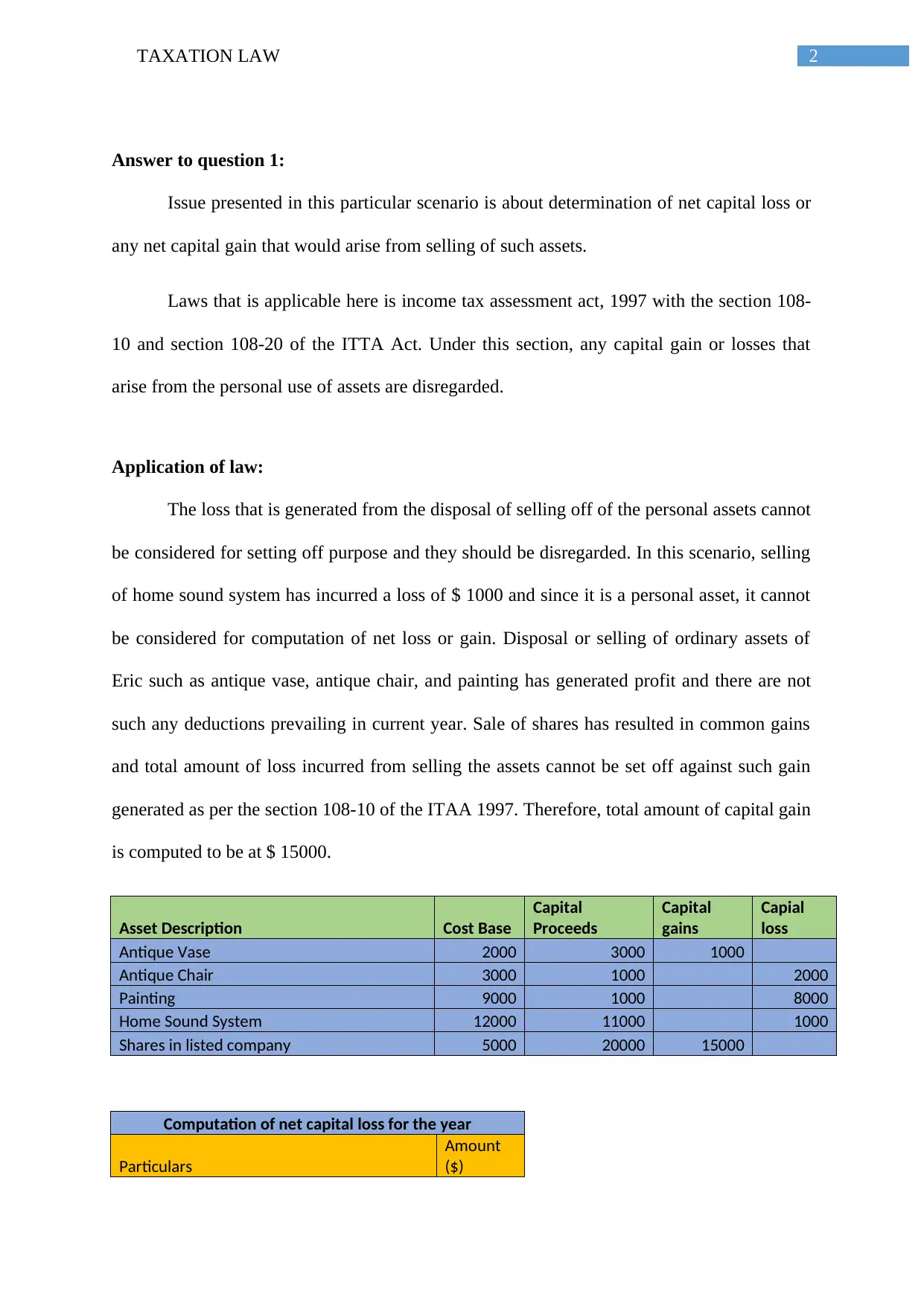
2TAXATION LAW
Answer to question 1:
Issue presented in this particular scenario is about determination of net capital loss or
any net capital gain that would arise from selling of such assets.
Laws that is applicable here is income tax assessment act, 1997 with the section 108-
10 and section 108-20 of the ITTA Act. Under this section, any capital gain or losses that
arise from the personal use of assets are disregarded.
Application of law:
The loss that is generated from the disposal of selling off of the personal assets cannot
be considered for setting off purpose and they should be disregarded. In this scenario, selling
of home sound system has incurred a loss of $ 1000 and since it is a personal asset, it cannot
be considered for computation of net loss or gain. Disposal or selling of ordinary assets of
Eric such as antique vase, antique chair, and painting has generated profit and there are not
such any deductions prevailing in current year. Sale of shares has resulted in common gains
and total amount of loss incurred from selling the assets cannot be set off against such gain
generated as per the section 108-10 of the ITAA 1997. Therefore, total amount of capital gain
is computed to be at $ 15000.
Asset Description Cost Base
Capital
Proceeds
Capital
gains
Capial
loss
Antique Vase 2000 3000 1000
Antique Chair 3000 1000 2000
Painting 9000 1000 8000
Home Sound System 12000 11000 1000
Shares in listed company 5000 20000 15000
Computation of net capital loss for the year
Particulars
Amount
($)
Answer to question 1:
Issue presented in this particular scenario is about determination of net capital loss or
any net capital gain that would arise from selling of such assets.
Laws that is applicable here is income tax assessment act, 1997 with the section 108-
10 and section 108-20 of the ITTA Act. Under this section, any capital gain or losses that
arise from the personal use of assets are disregarded.
Application of law:
The loss that is generated from the disposal of selling off of the personal assets cannot
be considered for setting off purpose and they should be disregarded. In this scenario, selling
of home sound system has incurred a loss of $ 1000 and since it is a personal asset, it cannot
be considered for computation of net loss or gain. Disposal or selling of ordinary assets of
Eric such as antique vase, antique chair, and painting has generated profit and there are not
such any deductions prevailing in current year. Sale of shares has resulted in common gains
and total amount of loss incurred from selling the assets cannot be set off against such gain
generated as per the section 108-10 of the ITAA 1997. Therefore, total amount of capital gain
is computed to be at $ 15000.
Asset Description Cost Base
Capital
Proceeds
Capital
gains
Capial
loss
Antique Vase 2000 3000 1000
Antique Chair 3000 1000 2000
Painting 9000 1000 8000
Home Sound System 12000 11000 1000
Shares in listed company 5000 20000 15000
Computation of net capital loss for the year
Particulars
Amount
($)
⊘ This is a preview!⊘
Do you want full access?
Subscribe today to unlock all pages.

Trusted by 1+ million students worldwide
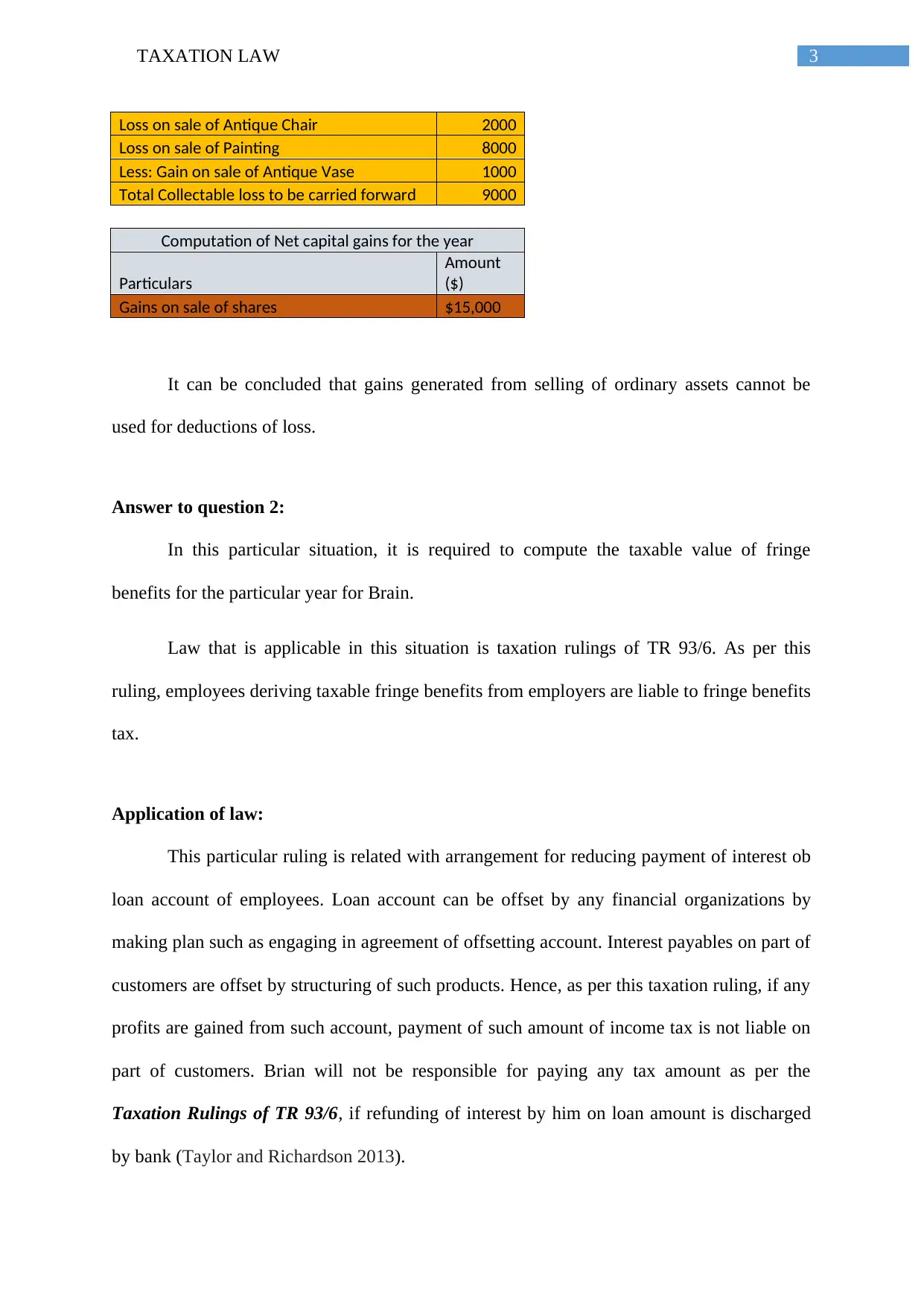
3TAXATION LAW
Loss on sale of Antique Chair 2000
Loss on sale of Painting 8000
Less: Gain on sale of Antique Vase 1000
Total Collectable loss to be carried forward 9000
Computation of Net capital gains for the year
Particulars
Amount
($)
Gains on sale of shares $15,000
It can be concluded that gains generated from selling of ordinary assets cannot be
used for deductions of loss.
Answer to question 2:
In this particular situation, it is required to compute the taxable value of fringe
benefits for the particular year for Brain.
Law that is applicable in this situation is taxation rulings of TR 93/6. As per this
ruling, employees deriving taxable fringe benefits from employers are liable to fringe benefits
tax.
Application of law:
This particular ruling is related with arrangement for reducing payment of interest ob
loan account of employees. Loan account can be offset by any financial organizations by
making plan such as engaging in agreement of offsetting account. Interest payables on part of
customers are offset by structuring of such products. Hence, as per this taxation ruling, if any
profits are gained from such account, payment of such amount of income tax is not liable on
part of customers. Brian will not be responsible for paying any tax amount as per the
Taxation Rulings of TR 93/6, if refunding of interest by him on loan amount is discharged
by bank (Taylor and Richardson 2013).
Loss on sale of Antique Chair 2000
Loss on sale of Painting 8000
Less: Gain on sale of Antique Vase 1000
Total Collectable loss to be carried forward 9000
Computation of Net capital gains for the year
Particulars
Amount
($)
Gains on sale of shares $15,000
It can be concluded that gains generated from selling of ordinary assets cannot be
used for deductions of loss.
Answer to question 2:
In this particular situation, it is required to compute the taxable value of fringe
benefits for the particular year for Brain.
Law that is applicable in this situation is taxation rulings of TR 93/6. As per this
ruling, employees deriving taxable fringe benefits from employers are liable to fringe benefits
tax.
Application of law:
This particular ruling is related with arrangement for reducing payment of interest ob
loan account of employees. Loan account can be offset by any financial organizations by
making plan such as engaging in agreement of offsetting account. Interest payables on part of
customers are offset by structuring of such products. Hence, as per this taxation ruling, if any
profits are gained from such account, payment of such amount of income tax is not liable on
part of customers. Brian will not be responsible for paying any tax amount as per the
Taxation Rulings of TR 93/6, if refunding of interest by him on loan amount is discharged
by bank (Taylor and Richardson 2013).
Paraphrase This Document
Need a fresh take? Get an instant paraphrase of this document with our AI Paraphraser
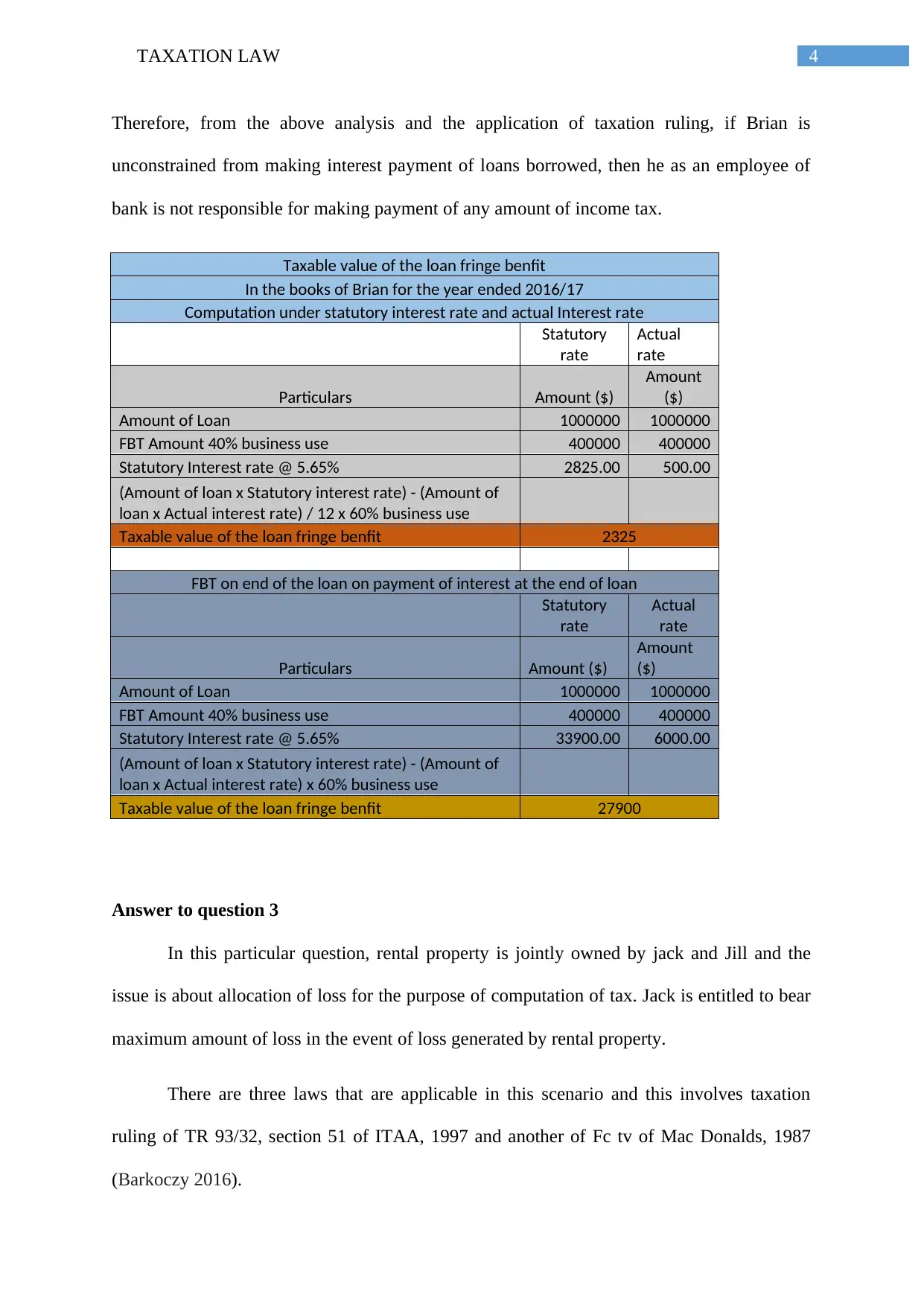
4TAXATION LAW
Therefore, from the above analysis and the application of taxation ruling, if Brian is
unconstrained from making interest payment of loans borrowed, then he as an employee of
bank is not responsible for making payment of any amount of income tax.
Taxable value of the loan fringe benfit
In the books of Brian for the year ended 2016/17
Computation under statutory interest rate and actual Interest rate
Statutory
rate
Actual
rate
Particulars Amount ($)
Amount
($)
Amount of Loan 1000000 1000000
FBT Amount 40% business use 400000 400000
Statutory Interest rate @ 5.65% 2825.00 500.00
(Amount of loan x Statutory interest rate) - (Amount of
loan x Actual interest rate) / 12 x 60% business use
Taxable value of the loan fringe benfit 2325
FBT on end of the loan on payment of interest at the end of loan
Statutory
rate
Actual
rate
Particulars Amount ($)
Amount
($)
Amount of Loan 1000000 1000000
FBT Amount 40% business use 400000 400000
Statutory Interest rate @ 5.65% 33900.00 6000.00
(Amount of loan x Statutory interest rate) - (Amount of
loan x Actual interest rate) x 60% business use
Taxable value of the loan fringe benfit 27900
Answer to question 3
In this particular question, rental property is jointly owned by jack and Jill and the
issue is about allocation of loss for the purpose of computation of tax. Jack is entitled to bear
maximum amount of loss in the event of loss generated by rental property.
There are three laws that are applicable in this scenario and this involves taxation
ruling of TR 93/32, section 51 of ITAA, 1997 and another of Fc tv of Mac Donalds, 1987
(Barkoczy 2016).
Therefore, from the above analysis and the application of taxation ruling, if Brian is
unconstrained from making interest payment of loans borrowed, then he as an employee of
bank is not responsible for making payment of any amount of income tax.
Taxable value of the loan fringe benfit
In the books of Brian for the year ended 2016/17
Computation under statutory interest rate and actual Interest rate
Statutory
rate
Actual
rate
Particulars Amount ($)
Amount
($)
Amount of Loan 1000000 1000000
FBT Amount 40% business use 400000 400000
Statutory Interest rate @ 5.65% 2825.00 500.00
(Amount of loan x Statutory interest rate) - (Amount of
loan x Actual interest rate) / 12 x 60% business use
Taxable value of the loan fringe benfit 2325
FBT on end of the loan on payment of interest at the end of loan
Statutory
rate
Actual
rate
Particulars Amount ($)
Amount
($)
Amount of Loan 1000000 1000000
FBT Amount 40% business use 400000 400000
Statutory Interest rate @ 5.65% 33900.00 6000.00
(Amount of loan x Statutory interest rate) - (Amount of
loan x Actual interest rate) x 60% business use
Taxable value of the loan fringe benfit 27900
Answer to question 3
In this particular question, rental property is jointly owned by jack and Jill and the
issue is about allocation of loss for the purpose of computation of tax. Jack is entitled to bear
maximum amount of loss in the event of loss generated by rental property.
There are three laws that are applicable in this scenario and this involves taxation
ruling of TR 93/32, section 51 of ITAA, 1997 and another of Fc tv of Mac Donalds, 1987
(Barkoczy 2016).
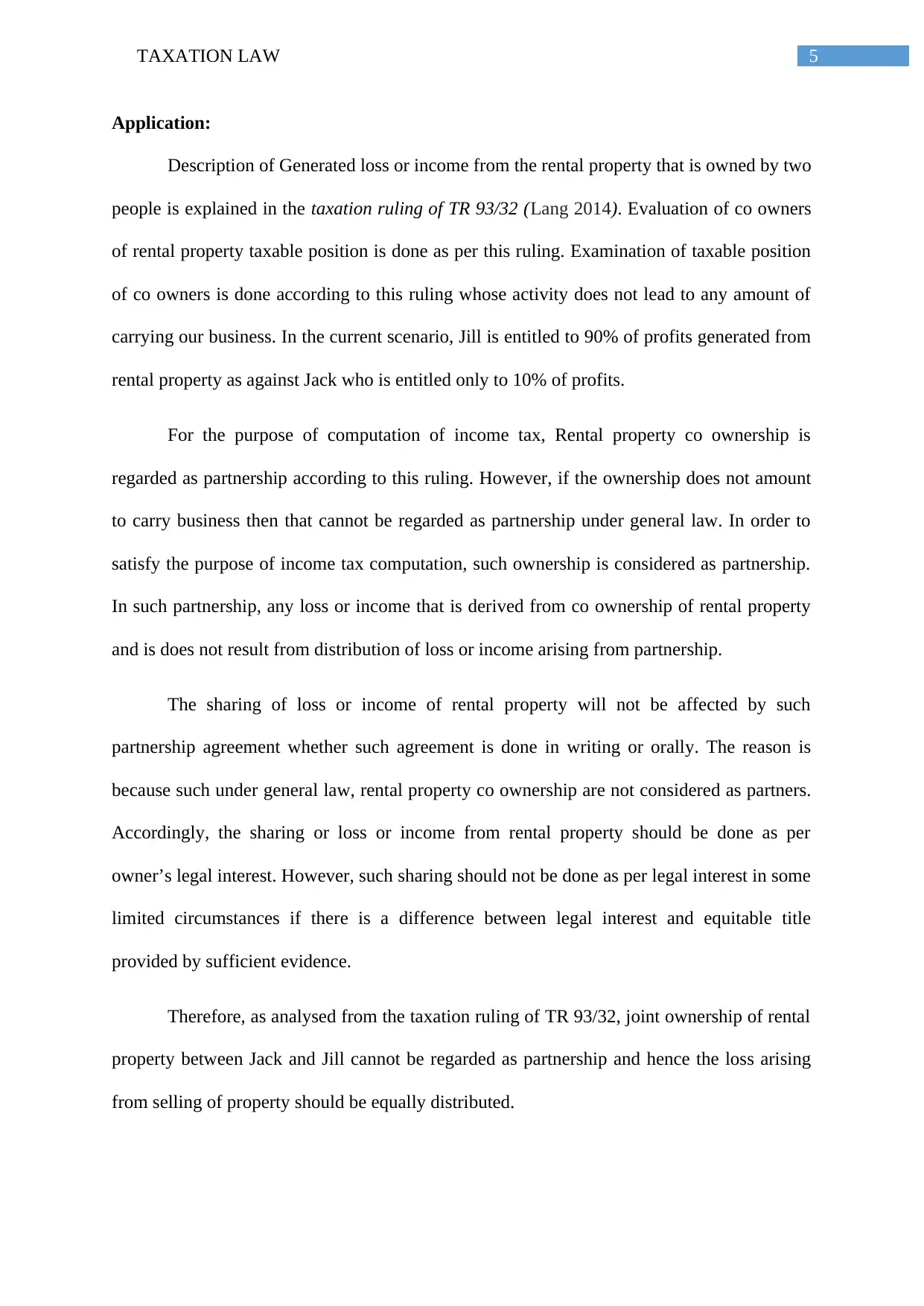
5TAXATION LAW
Application:
Description of Generated loss or income from the rental property that is owned by two
people is explained in the taxation ruling of TR 93/32 (Lang 2014). Evaluation of co owners
of rental property taxable position is done as per this ruling. Examination of taxable position
of co owners is done according to this ruling whose activity does not lead to any amount of
carrying our business. In the current scenario, Jill is entitled to 90% of profits generated from
rental property as against Jack who is entitled only to 10% of profits.
For the purpose of computation of income tax, Rental property co ownership is
regarded as partnership according to this ruling. However, if the ownership does not amount
to carry business then that cannot be regarded as partnership under general law. In order to
satisfy the purpose of income tax computation, such ownership is considered as partnership.
In such partnership, any loss or income that is derived from co ownership of rental property
and is does not result from distribution of loss or income arising from partnership.
The sharing of loss or income of rental property will not be affected by such
partnership agreement whether such agreement is done in writing or orally. The reason is
because such under general law, rental property co ownership are not considered as partners.
Accordingly, the sharing or loss or income from rental property should be done as per
owner’s legal interest. However, such sharing should not be done as per legal interest in some
limited circumstances if there is a difference between legal interest and equitable title
provided by sufficient evidence.
Therefore, as analysed from the taxation ruling of TR 93/32, joint ownership of rental
property between Jack and Jill cannot be regarded as partnership and hence the loss arising
from selling of property should be equally distributed.
Application:
Description of Generated loss or income from the rental property that is owned by two
people is explained in the taxation ruling of TR 93/32 (Lang 2014). Evaluation of co owners
of rental property taxable position is done as per this ruling. Examination of taxable position
of co owners is done according to this ruling whose activity does not lead to any amount of
carrying our business. In the current scenario, Jill is entitled to 90% of profits generated from
rental property as against Jack who is entitled only to 10% of profits.
For the purpose of computation of income tax, Rental property co ownership is
regarded as partnership according to this ruling. However, if the ownership does not amount
to carry business then that cannot be regarded as partnership under general law. In order to
satisfy the purpose of income tax computation, such ownership is considered as partnership.
In such partnership, any loss or income that is derived from co ownership of rental property
and is does not result from distribution of loss or income arising from partnership.
The sharing of loss or income of rental property will not be affected by such
partnership agreement whether such agreement is done in writing or orally. The reason is
because such under general law, rental property co ownership are not considered as partners.
Accordingly, the sharing or loss or income from rental property should be done as per
owner’s legal interest. However, such sharing should not be done as per legal interest in some
limited circumstances if there is a difference between legal interest and equitable title
provided by sufficient evidence.
Therefore, as analysed from the taxation ruling of TR 93/32, joint ownership of rental
property between Jack and Jill cannot be regarded as partnership and hence the loss arising
from selling of property should be equally distributed.
⊘ This is a preview!⊘
Do you want full access?
Subscribe today to unlock all pages.

Trusted by 1+ million students worldwide
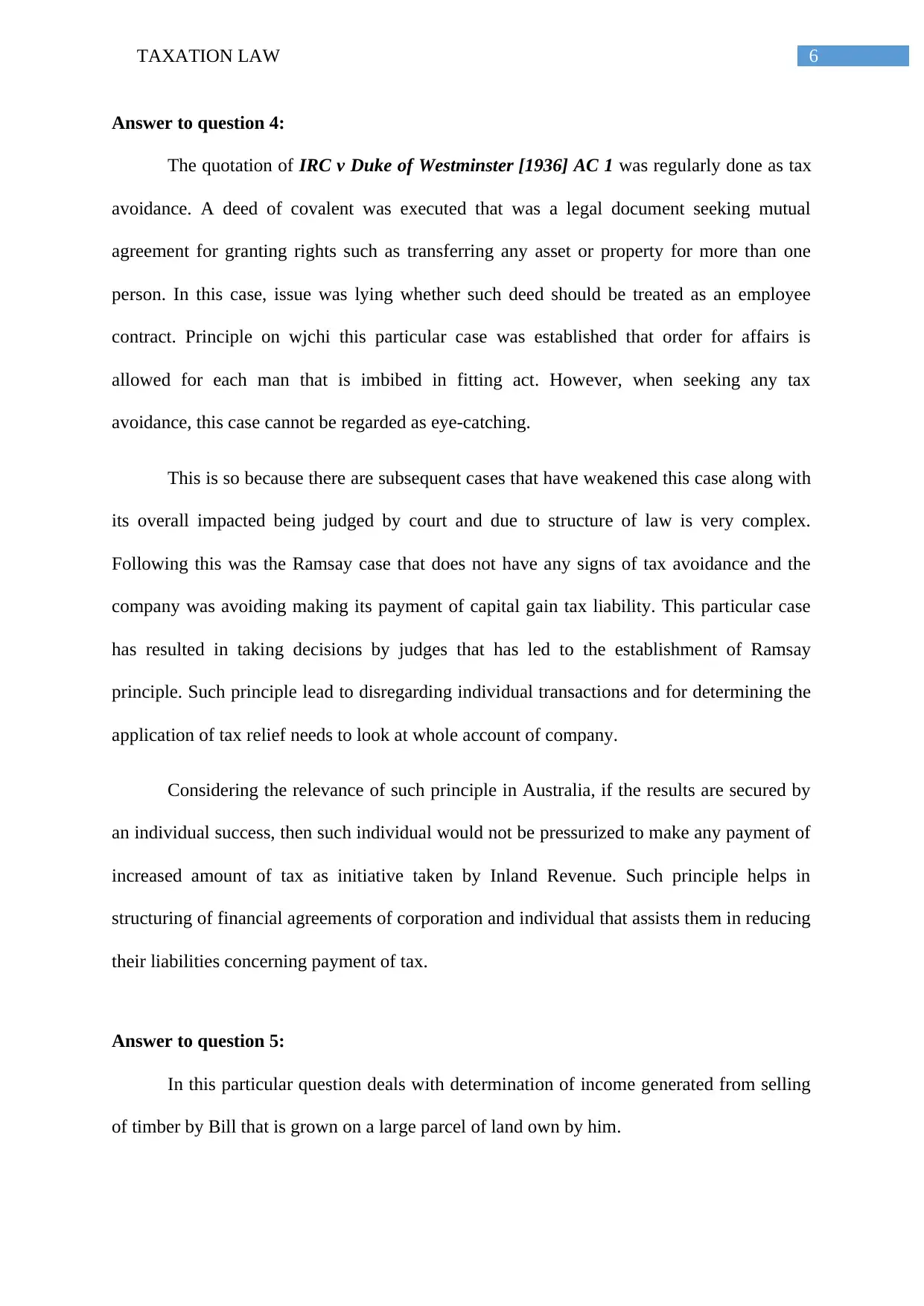
6TAXATION LAW
Answer to question 4:
The quotation of IRC v Duke of Westminster [1936] AC 1 was regularly done as tax
avoidance. A deed of covalent was executed that was a legal document seeking mutual
agreement for granting rights such as transferring any asset or property for more than one
person. In this case, issue was lying whether such deed should be treated as an employee
contract. Principle on wjchi this particular case was established that order for affairs is
allowed for each man that is imbibed in fitting act. However, when seeking any tax
avoidance, this case cannot be regarded as eye-catching.
This is so because there are subsequent cases that have weakened this case along with
its overall impacted being judged by court and due to structure of law is very complex.
Following this was the Ramsay case that does not have any signs of tax avoidance and the
company was avoiding making its payment of capital gain tax liability. This particular case
has resulted in taking decisions by judges that has led to the establishment of Ramsay
principle. Such principle lead to disregarding individual transactions and for determining the
application of tax relief needs to look at whole account of company.
Considering the relevance of such principle in Australia, if the results are secured by
an individual success, then such individual would not be pressurized to make any payment of
increased amount of tax as initiative taken by Inland Revenue. Such principle helps in
structuring of financial agreements of corporation and individual that assists them in reducing
their liabilities concerning payment of tax.
Answer to question 5:
In this particular question deals with determination of income generated from selling
of timber by Bill that is grown on a large parcel of land own by him.
Answer to question 4:
The quotation of IRC v Duke of Westminster [1936] AC 1 was regularly done as tax
avoidance. A deed of covalent was executed that was a legal document seeking mutual
agreement for granting rights such as transferring any asset or property for more than one
person. In this case, issue was lying whether such deed should be treated as an employee
contract. Principle on wjchi this particular case was established that order for affairs is
allowed for each man that is imbibed in fitting act. However, when seeking any tax
avoidance, this case cannot be regarded as eye-catching.
This is so because there are subsequent cases that have weakened this case along with
its overall impacted being judged by court and due to structure of law is very complex.
Following this was the Ramsay case that does not have any signs of tax avoidance and the
company was avoiding making its payment of capital gain tax liability. This particular case
has resulted in taking decisions by judges that has led to the establishment of Ramsay
principle. Such principle lead to disregarding individual transactions and for determining the
application of tax relief needs to look at whole account of company.
Considering the relevance of such principle in Australia, if the results are secured by
an individual success, then such individual would not be pressurized to make any payment of
increased amount of tax as initiative taken by Inland Revenue. Such principle helps in
structuring of financial agreements of corporation and individual that assists them in reducing
their liabilities concerning payment of tax.
Answer to question 5:
In this particular question deals with determination of income generated from selling
of timber by Bill that is grown on a large parcel of land own by him.
Paraphrase This Document
Need a fresh take? Get an instant paraphrase of this document with our AI Paraphraser
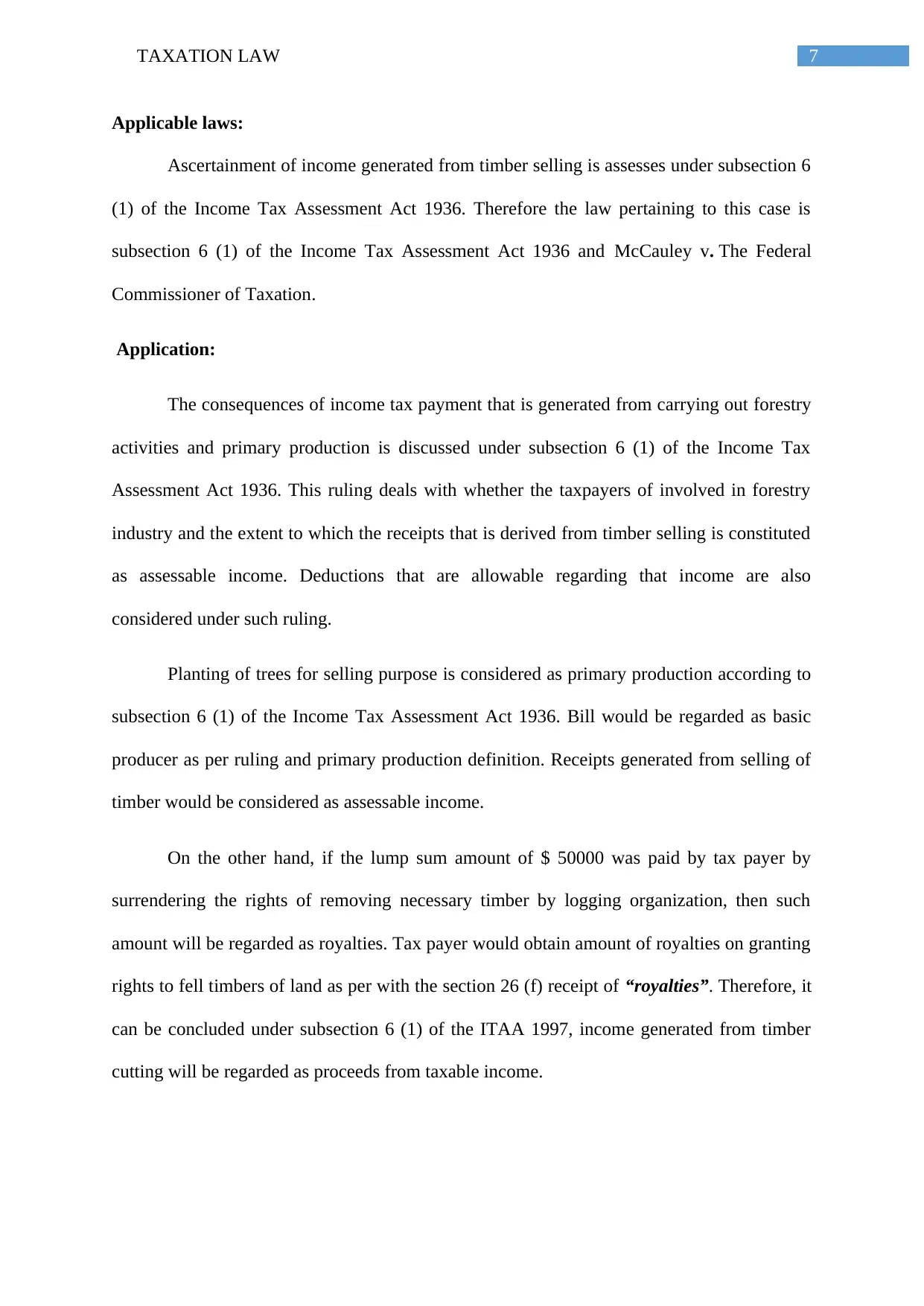
7TAXATION LAW
Applicable laws:
Ascertainment of income generated from timber selling is assesses under subsection 6
(1) of the Income Tax Assessment Act 1936. Therefore the law pertaining to this case is
subsection 6 (1) of the Income Tax Assessment Act 1936 and McCauley v. The Federal
Commissioner of Taxation.
Application:
The consequences of income tax payment that is generated from carrying out forestry
activities and primary production is discussed under subsection 6 (1) of the Income Tax
Assessment Act 1936. This ruling deals with whether the taxpayers of involved in forestry
industry and the extent to which the receipts that is derived from timber selling is constituted
as assessable income. Deductions that are allowable regarding that income are also
considered under such ruling.
Planting of trees for selling purpose is considered as primary production according to
subsection 6 (1) of the Income Tax Assessment Act 1936. Bill would be regarded as basic
producer as per ruling and primary production definition. Receipts generated from selling of
timber would be considered as assessable income.
On the other hand, if the lump sum amount of $ 50000 was paid by tax payer by
surrendering the rights of removing necessary timber by logging organization, then such
amount will be regarded as royalties. Tax payer would obtain amount of royalties on granting
rights to fell timbers of land as per with the section 26 (f) receipt of “royalties”. Therefore, it
can be concluded under subsection 6 (1) of the ITAA 1997, income generated from timber
cutting will be regarded as proceeds from taxable income.
Applicable laws:
Ascertainment of income generated from timber selling is assesses under subsection 6
(1) of the Income Tax Assessment Act 1936. Therefore the law pertaining to this case is
subsection 6 (1) of the Income Tax Assessment Act 1936 and McCauley v. The Federal
Commissioner of Taxation.
Application:
The consequences of income tax payment that is generated from carrying out forestry
activities and primary production is discussed under subsection 6 (1) of the Income Tax
Assessment Act 1936. This ruling deals with whether the taxpayers of involved in forestry
industry and the extent to which the receipts that is derived from timber selling is constituted
as assessable income. Deductions that are allowable regarding that income are also
considered under such ruling.
Planting of trees for selling purpose is considered as primary production according to
subsection 6 (1) of the Income Tax Assessment Act 1936. Bill would be regarded as basic
producer as per ruling and primary production definition. Receipts generated from selling of
timber would be considered as assessable income.
On the other hand, if the lump sum amount of $ 50000 was paid by tax payer by
surrendering the rights of removing necessary timber by logging organization, then such
amount will be regarded as royalties. Tax payer would obtain amount of royalties on granting
rights to fell timbers of land as per with the section 26 (f) receipt of “royalties”. Therefore, it
can be concluded under subsection 6 (1) of the ITAA 1997, income generated from timber
cutting will be regarded as proceeds from taxable income.
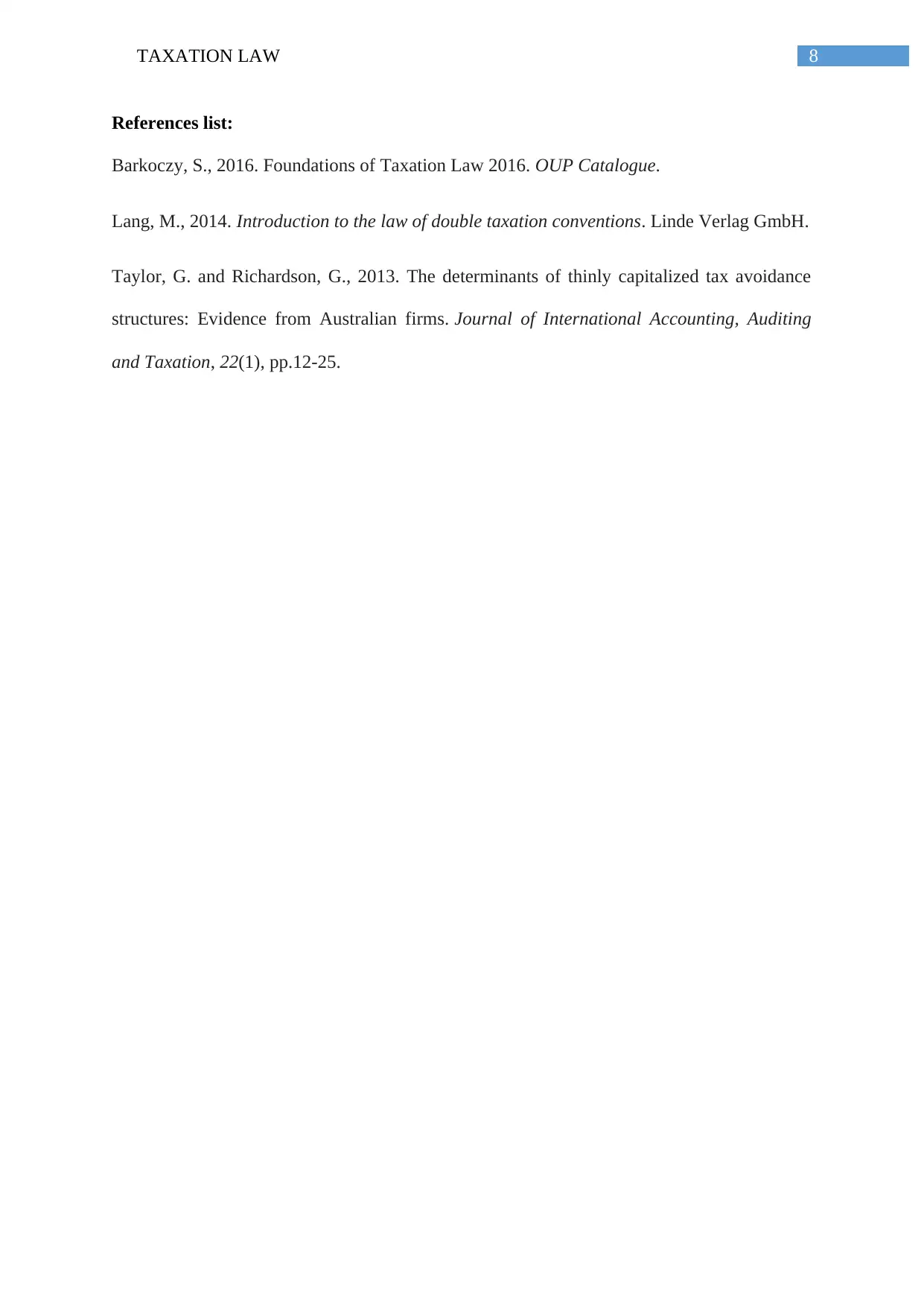
8TAXATION LAW
References list:
Barkoczy, S., 2016. Foundations of Taxation Law 2016. OUP Catalogue.
Lang, M., 2014. Introduction to the law of double taxation conventions. Linde Verlag GmbH.
Taylor, G. and Richardson, G., 2013. The determinants of thinly capitalized tax avoidance
structures: Evidence from Australian firms. Journal of International Accounting, Auditing
and Taxation, 22(1), pp.12-25.
References list:
Barkoczy, S., 2016. Foundations of Taxation Law 2016. OUP Catalogue.
Lang, M., 2014. Introduction to the law of double taxation conventions. Linde Verlag GmbH.
Taylor, G. and Richardson, G., 2013. The determinants of thinly capitalized tax avoidance
structures: Evidence from Australian firms. Journal of International Accounting, Auditing
and Taxation, 22(1), pp.12-25.
⊘ This is a preview!⊘
Do you want full access?
Subscribe today to unlock all pages.

Trusted by 1+ million students worldwide

9TAXATION LAW
1 out of 10
Related Documents
Your All-in-One AI-Powered Toolkit for Academic Success.
+13062052269
info@desklib.com
Available 24*7 on WhatsApp / Email
![[object Object]](/_next/static/media/star-bottom.7253800d.svg)
Unlock your academic potential
Copyright © 2020–2025 A2Z Services. All Rights Reserved. Developed and managed by ZUCOL.





